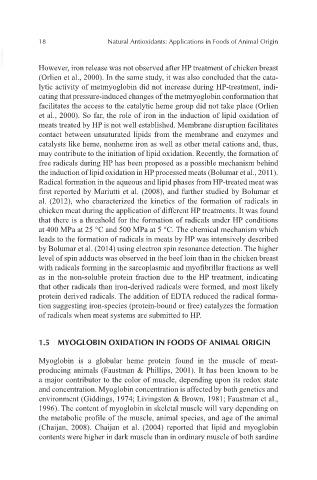Page 39 - Natural Antioxidants, Applications in Foods of Animal Origin
P. 39
18 Natural Antioxidants: Applications in Foods of Animal Origin
VetBooks.ir However, iron release was not observed after HP treatment of chicken breast
(Orlien et al., 2000). In the same study, it was also concluded that the cata-
lytic activity of metmyoglobin did not increase during HP-treatment, indi-
cating that pressure-induced changes of the metmyoglobin conformation that
facilitates the access to the catalytic heme group did not take place (Orlien
et al., 2000). So far, the role of iron in the induction of lipid oxidation of
meats treated by HP is not well established. Membrane disruption facilitates
contact between unsaturated lipids from the membrane and enzymes and
catalysts like heme, nonheme iron as well as other metal cations and, thus,
may contribute to the initiation of lipid oxidation. Recently, the formation of
free radicals during HP has been proposed as a possible mechanism behind
the induction of lipid oxidation in HP processed meats (Bolumar et al., 2011).
Radical formation in the aqueous and lipid phases from HP-treated meat was
first reported by Mariutti et al. (2008), and further studied by Bolumar et
al. (2012), who characterized the kinetics of the formation of radicals in
chicken meat during the application of different HP treatments. It was found
that there is a threshold for the formation of radicals under HP conditions
at 400 MPa at 25 °C and 500 MPa at 5 °C. The chemical mechanism which
leads to the formation of radicals in meats by HP was intensively described
by Bolumar et al. (2014) using electron spin resonance detection. The higher
level of spin adducts was observed in the beef loin than in the chicken breast
with radicals forming in the sarcoplasmic and myofibrillar fractions as well
as in the non-soluble protein fraction due to the HP treatment, indicating
that other radicals than iron-derived radicals were formed, and most likely
protein derived radicals. The addition of EDTA reduced the radical forma-
tion suggesting iron-species (protein-bound or free) catalyzes the formation
of radicals when meat systems are submitted to HP.
1.5 MYOGLOBIN OXIDATION IN FOODS OF ANIMAL ORIGIN
Myoglobin is a globular heme protein found in the muscle of meat-
producing animals (Faustman & Phillips, 2001). It has been known to be
a major contributor to the color of muscle, depending upon its redox state
and concentration. Myoglobin concentration is affected by both genetics and
environment (Giddings, 1974; Livingston & Brown, 1981; Faustman et al.,
1996). The content of myoglobin in skeletal muscle will vary depending on
the metabolic profile of the muscle, animal species, and age of the animal
(Chaijan, 2008). Chaijan et al. (2004) reported that lipid and myoglobin
contents were higher in dark muscle than in ordinary muscle of both sardine

